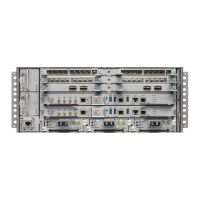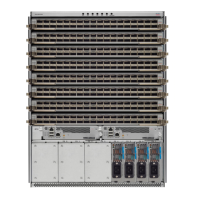The routes/labels are then advertised using LSPs. The next hop for the route is changed at each ABR to local
router which removes the need to leak OSPF routes across area boundaries. The bandwidth available on each
of the core links is mapped to OSPF cost, hence it is imperative that BGP carries this cost correctly between
each of the PEs. This functionality is achieved by using the AiGP.
BFD Multihop Support for BGP
Bi-directional Forwarding Detection Multihop (BFD-MH) support is enabled for BGP. BFD Multihop
establishes a BFD session between two addresses that may span multiple network hops. Cisco IOS XR Software
BFD Multihop is based on RFC 5883. For more information on BFD Multihop, refer Interface and Hardware
Component Configuration Guide for Cisco NCS 6000 Series Routers and Interface and Hardware Component
Command Reference for Cisco NCS 6000 Series RoutersInterface and Hardware Component Command
Reference for Cisco NCS 5000 Series Routers .
BGP Multi-Instance and Multi-AS
Multiple BGP instances are supported on the router corresponding to a Autonomous System (AS). Each BGP
instance is a separate process running on the same or on a different RP/DRP node. The BGP instances do not
share any prefix table between them. No need for a common adj-rib-in (bRIB) as is the case with distributed
BGP. The BGP instances do not communicate with each other and do not set up peering with each other. Each
individual instance can set up peering with another router independently.
Multi-AS BGP enables configuring each instance of a multi-instance BGP with a different AS number.
Multi-Instance and Multi-AS BGP provides these capabilities:
• Mechanism to consolidate the services provided by multiple routers using a common routing infrastructure
into a single IOS-XR router.
• Mechanism to achieve AF isolation by configuring the different AFs in different BGP instances.
• Means to achieve higher session scale by distributing the overall peering sessions between multiple
instances.
• Mechanism to achieve higher prefix scale (especially on a RR) by having different instances carrying
different BGP tables.
• Improved BGP convergence under certain scenarios.
• All BGP functionalities including NSR are supported for all the instances.
• The load and commit router-level operations can be performed on previously verified or applied
configurations.
Restrictions
• The router supports maximum of 4 BGP instances.
• Each BGP instance needs a unique router-id.
• Only one Address Family can be configured under each BGP instance (VPNv4, VPNv6 and RT-Constrain
can be configured under multiple BGP instances).
• IPv4/IPv6 Unicast should be within the same BGP instance in which IPv4/IPv6 Labeled-Unicast is
configured.
Routing Configuration Guide for Cisco NCS 6000 Series Routers, IOS XR Release 6.4.x
43
Implementing BGP
BFD Multihop Support for BGP

